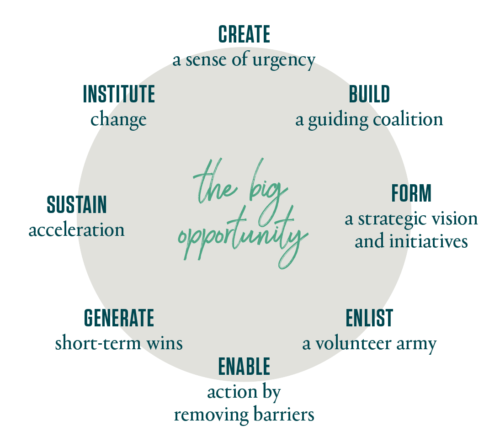
For more on racial justice from Blue Garnet, check out our other essays in this series: 1, 2, 3, 4.
Welcome back to Part 2 of this “Taking Stock” essay. Part 1 focused on taking stock as an individual. Now that we’re all self-aware leaders (ok…at least have started our personal journeys), we are better equipped to lead our organizations through the transformational change to center racial justice.
“Taking stock” at the organization-level starts with addressing 5 key questions:
- How has systemic racism impacted your organization?
- Who are you hiring, and how are you orienting and developing them to support a culture of racial equity?
- [For philanthropies] Who are you funding, and are you investing in organizations led by people most proximate to the challenges of their communities?
- How are you resourcing your efforts to center racial equity?
- How will you manage this organizational transformation to center racial equity?
One quick note before we dive in. Think about who needs to be “at the table” when you’re answering these questions. A poll during NP Quarterly’s “Beyond the Board Statement: How Can Boards Join the Movement for Racial Justice?” webinar showed that while 70% of participant organizations had issued a public statement addressing racial equity since the murder of George Floyd, only half (52%) of those organizations involved their board in framing it. Your organization cannot make transformational change without the support of your board. They need to be involved of the process if you truly are going to center racial justice. Ok – back to our five questions:
Q1: How has systemic racism impacted your organization?
Even if your organization’s mission does not explicitly tackle racial justice, look at your mission, programs, and history through a “racial justice lens.” Ask yourself – how has systemic racism played a part in our history? How has it impacted our constituents? Staff? Leaders? Who has benefitted and how? Involve your board and staff, and acknowledge that searching for this truth is going to get uncomfortable. Once you’ve acknowledged this history and context, you can start to figure out what to do about it.
A good example is The National Park Conservation Association. Last year, it published its Statement of Intentions which included: “We also know our visionary founders marginalized certain people. We were not always on the right side of justice; we helped pioneer the concept of public lands but excluded important voices in the creation of national parks and our organization. And many of our national parks and public lands were created by forcibly removing those who called them home. That history cannot be unlived, but facing these difficult truths allow us to do our best work going forward.”
Let’s be honest about our history, then commit to changing the path of our future.
Q2: Who are you hiring, and how are you orienting and developing them to support a culture of racial equity?
Who is more equipped to fight for racial justice than those who have experienced the trauma of systemic racism firsthand? Moreover, there is a multitude of studies showing the benefits of workforce diversity, including increased innovation and financial gains. Having a diverse workforce (or at least adopting policies to work towards increasing diversity) is also a tangible symbol of your authentic commitment to centering racial justice.
One way to get real data and hold yourself accountable to equitable hiring practices (and funding practices, too!) is to conduct a “Diversity Audit.” In order to do so,
- Articulate who your constituency specifically is (e.g. all African American youth in the City of Los Angeles).
- Beyond your constituency, discuss other ways is it important for your organization to be diverse, including – but not limited to – race/ethnicity, gender, age, income level, sexual orientation, physical and cognitive abilities, religious beliefs, immigration status, etc.
- Gather your “baseline” diversity data for how many of your board, management, and staff fit your prioritized diversity/social justice categories.
Beyond recruiting a diverse board or hiring a diverse workforce, you need to think about retaining them. Will your culture and norms allow Black, Indigenous, People of Color (BIPOC) members of board and staff to bring their authentic selves to work, or will they be required to adapt to a white-dominant culture, or serve as the token voice for their entire community? Do your salary and promotion policies ensure equity across marginalized populations? In answering these questions, check your retention numbers. Without realizing it, you may be struggling to retain diverse talent with valuable perspectives and ideas that you worked so hard to bring in. If you do happen to lose diverse team members, be sure to conduct an exit interview to better understand why.
We know that collecting sensitive information like this is not easy. It may help to keep the data anonymous, share only consolidated totals, and communicate that the purpose is to promote racial justice. Or you can hire a third party like Blue Garnet to help collect and draw insights from this information for you.
Once you know the “baseline,” set diversity targets for where you want your organization to be in the future. Then make an action plan for how to get there, and hold yourself accountable to results.
Q3: For philanthropies, who are you funding, and are you investing in organizations led by people most proximate to the challenges of their communities?
“Fund us like you want us to win” was a rallying cry to philanthropies from South Los Angeles community leader Gloria Walton, at a Southern California Grantmakers conversation we attended back in June. This quote really hit home for us. While the social sector may be well-intentioned, philanthropic redlining exists. A recent Bridgespan report found that organizations led by People of Color win less grant money than those with white leaders. And budgets for white-led organizations were 24% higher than those led by People of Color. We want to lift up Ms. Walton’s rallying cry to every philanthropic ear. It’s time to do the work – to transition your DEI statements to grantmaking decisions.
Start by taking inventory of your past grants. What does board and executive leadership look like at the organizations you fund? How does that compare with the communities the grantees serve? And how do you make it easier (or harder) for organizations led by community leaders to access and ensure your partnership? This simple step can help open eyes to implicit biases that exist in your organization’s grantmaking.
Similar to Q2 above – once you know your funding diversity “baseline” – review and adapt your policies, set future diversity goals, and develop an action plan to achieve them. (Pro Tip: You can conduct a diversity audit for your grantees using the same approach above).
Q4: How are you resourcing your efforts to center racial equity?
As we all know, transforming your organization to center racial justice takes significant time and resources. If you are making a genuine commitment, you need to allocate appropriate staff capacity and budget to support the process of transformation. Think of your budget as a “moral document,” as it illuminates your organization’s true priorities. Take a look at yours and consider if you’re “putting your money where your mouth is:”
- Do you have funds for emergent, equity-focused strategies (e.g. programmatic changes, advocacy)?
- Where are the funds for on-going equity training for staff, leaders, and Board members?
- Take a deeper look at your compensation across gender, race/ethnicity, age, and other social justice characteristics. If you find implicit bias in your compensation practices – do the work to make it right.
- Do you have funds to hire people or consultants to help inform and execute this transformation? Most organizations are stretched thin already. Simply adding these responsibilities to someone’s already full plate will reduce the likelihood of achieving your results.
Question 5: How will you manage this organizational transformation to center racial equity?

For most organizations, centering racial justice is a significant, foundational change that will require thoughtful, strategic change management. Every organization will encounter resistance and roadblocks, because change is hard. Each individual transitions at their own pace, “letting go” of the way things used to be. Kotter’s 8-step process (see visual) is a helpful framework to execute transformation. Additionally, working to create shared leadership and an inclusive culture will provide a stable foundation to see this change through.
We know that “taking stock” is just the first step in a long journey to center racial justice. Blue Garnet is on the same journey. Though we may have started our journey earlier, we’re still learning, too. What steps have you taken (or want to take)? Let us know if you need a strategic thought partner to take steps towards racial justice and to manage this change at your organization.
For more on racial justice from Blue Garnet, check out our other essays in this series: 1, 2, 3, 4, and 5.1.
